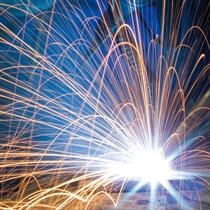
Projection Welding Electrodes
Luvata is one of the most respected manufacturers of resistance-welding electrodes.

A-Trode® is the universal cap electrode for resistance welding of light-to-medium gauge coated and uncoated steels. A-Trode's freedom from oxygen allows us to alloy the copper with the optimum levels of chrome and zirconium.
Alloy: Copper Chrome Zirconium (CuCrZr)
Quality Specifications
| Alloy | C18150 CuCrZr, EN ISO 5182 A2/2, DIN 17666 Wn 2.1293, RWMA Class II |
| Chemical composition | Cr 0.7% to 1.2%, Zr 0.06% to 0.15%. Others max. 0.2%, Cu balance |
| Physical material properties at 200C | Mass: 8.9g/cm3 Specific heat: 376 J/kg.K Thermal conductivity: 320 W/m.K Expansion coefficient (20-300oC): 17.0 x 10-6 m/mK Electric conductivity: min. 43 S/m (solution annealed and hardened) min 74% IACS Softening temperature: min. 500°C |
| Dimensions and tolerances | To ISO 5821 or other standards as required. Special electrodes to customer drawing |
| Packaging | Most items in cartons of 500 pieces. |
| Documentation | Acceptance test certificate EN 10204 3.1 B possible if desired against a charge. |
| Area of application | Male and female resistance welding electrodes. Backing dies - series and indirect Seam welding wheels Projection welding electrodes |
Mechanical Specifications - Quality
| Form of supply | Tensile strength [N/mm2] | 0.2% Offset yield strength [N/mm2] | Elongation AS [%] | Hardness |
Electrodes | ≥ 490 | ≥ 430 | ≥ 15 | ≥ 172 |
Physical Properties
| Hardness at ambient temperature: | Minimum 80 HRB |
| Conductivity: | Minimum 80% IACS |

Kova® - the 'beryllium-free' alloy made of copper, nickel, silicon and chromium (CuNiSiCr).
Kova is a high-strength, beryllium-free precipitation hardening alloy with medium-high electrical and thermal conductivity.
Kova is the perfect replacement for harmful beryllium copper alloys.
Benefits:
- Easy to machine and form
- Extended use due to hardness
- High strength with moderate thermal and electrical conductivity
- Easy disposal
Applications:
- Adaptors
- Shanks
- Projection welding electrodes
- Weld wheels
Specifications:
| Alloy | Kova® NK203 is a RWMA Class III alloy |
| Chemical composition | Ni 1.8 - 3.0%; Si 0.4 - 0.8%; Cr 0.1 - 0.8%; Fe 0.15% max;. Cu balance |
| Physical, electrical and thermal properties | Density: 8.8 kg/dm3 Coefficient of linear expansion: 0.0000175 1/K Specific heat: 380 J/(kg x K) |
| Documentation | Acceptance test certificate EN-CEN/TS 13388:2008 |
Errors and omissions excepted. Values given are industry standards.
Mechanical Specifications
| Form of supply | Tensile strength [N/mm2] | 0.2% Offset yield strength [N/mm2] | Elongation AS [%] | Hardness HV |
| Adapters | 650-800 | 650-750 | 9-15 | 220-225 |


Advantages
- Longer weld life
- Non-stick
- Reduces energy requirements
- Works on all steels
- Lowers manufacturing costs
Quality Properties*
| Alloy | C15760 CuAl2O3, EN ISO 5182 C20/1, RWMA Class 20 |
| Chemical composition | Aluminum 0.60% by weight as Al2O3 Cu balance |
| Physical material properties at 20oC | Density: 8.81g/cm3 Thermal conductivity: 322 W/m.K Expansion coefficient (20-150°C): 16.6 x 10-6 m/mK Electric conductivity: 78% IACS Softening temperature: 1083°C |
| Dimensions and tolerances | To ISO 5821 or other standards as required. Special electrodes to customer drawing. |
| Packaging | Most items in cartons of 500 pieces |
| Documentation | Acceptance test certificate EN 10204 3.1 B possible if desired against a charge. |
| Area of application | Male and female resistance welding electrode Backing dies - series and indirect Projection welding electrodes |
Mechanical Properties*
| Form of supply | Tensile strength MPa | Yield strength MPa | Elongation [%] | Hardness HV |
Electrodes | 489 - 537 | 393 - 441 | 18 - 23% | 160 |
Physical Properties*
| Hardness at ambient temperature: | 83 HRB |
| Conductivity: | 78% IACS |
*Errors and omissions excepted. Values given are industry standards. Actual properties will vary dependent upon amount of cold work.
Traceability
All materials are fully traceable. Nitrode® electrodes can be recognized by their single knurls markings.





